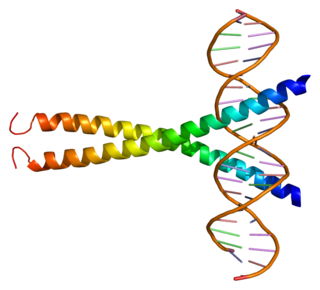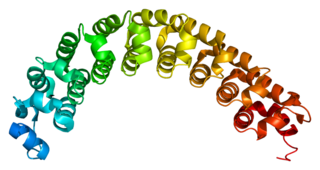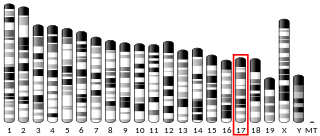
A germ cell is any cell that gives rise to the gametes of an organism that reproduces sexually. In many animals, the germ cells originate in the primitive streak and migrate via the gut of an embryo to the developing gonads. There, they undergo meiosis, followed by cellular differentiation into mature gametes, either eggs or sperm. Unlike animals, plants do not have germ cells designated in early development. Instead, germ cells can arise from somatic cells in the adult, such as the floral meristem of flowering plants.

Growth/differentiation factor 9 is a protein that in humans is encoded by the GDF9 gene.

Transforming growth factor beta receptor I is a membrane-bound TGF beta receptor protein of the TGF-beta receptor family for the TGF beta superfamily of signaling ligands. TGFBR1 is its human gene.

Growth differentiation factor-3 (GDF3), also known as Vg-related gene 2 (Vgr-2) is protein that in humans is encoded by the GDF3 gene. GDF3 belongs to the transforming growth factor beta (TGF-β) superfamily. It has high similarity to other TGF-β superfamily members including Vg1 and GDF1.

Deleted in azoospermia-like is a protein that in humans is encoded by the DAZL gene.

cAMP responsive element modulator is a protein that in humans is encoded by the CREM gene, and it belongs to the cAMP-responsive element binding protein family. It has multiple isoforms, which act either as repressors or activators. CREB family is important for in regulating transcription in response to various stresses, metabolic and developmental signals. CREM transcription factors also play an important role in many physiological systems, such as cardiac function, circadian rhythms, locomotion and spermatogenesis.

E3 ubiquitin-protein ligase CHFR is an enzyme that in humans is encoded by the CHFR gene.

Deleted in azoospermia protein 3 is a protein that in humans is encoded by the DAZ3 gene.

Deleted in azoospermia protein 2 is a protein that in humans is encoded by the DAZ2 gene.

Citron Rho-interacting kinase is an enzyme that in humans is encoded by the CIT gene.

Pumilio homolog 2 is an RNA-binding protein that in humans is encoded by the PUM2 gene.

TFIIA-alpha and beta-like factor is a protein that in humans is encoded by the GTF2A1L gene.

Protein boule-like is a protein that in humans is encoded by the BOLL gene.

Calmegin, also known as CLGN, is a protein which in humans is encoded by the CLGN gene. Calmegin is also present in other animals including mice.

Sperm flagellar protein 2 is a protein that in humans is encoded by the SPEF2 gene.

Y-box-binding protein 2 is a protein that in humans is encoded by the YBX2 gene.

Ankyrin repeat, SAM and basic leucine zipper domain-containing protein 1 is a protein that in humans is encoded by the ASZ1 gene.
The midbody is a transient structure found in mammalian cells and is present near the end of cytokinesis just prior to the complete separation of the dividing cells. The structure was first described by Walther Flemming in 1891.

Homeobox protein NOBOX, also known as newborn ovary homeobox protein, is a protein that in humans is encoded by the NOBOX gene. The official symbol (NOBOX) and the official full name are maintained by the HGNC. The NOBOX gene is conserved in chimpanzee, Rhesus monkey, cow, mouse, and rat. There are 175 organisms that have orthologs with human gene NOBOX. It is capable of regulating other genes that are important in the development of follicles. Follicles do not develop and oocytes decrease in its absence which lead to infertility.

Testis expressed 15 is a protein that in humans is encoded by the TEX15 gene.


















